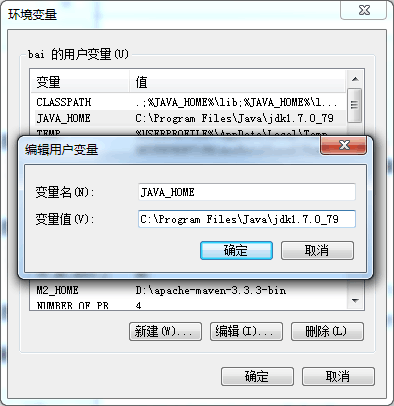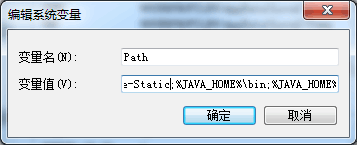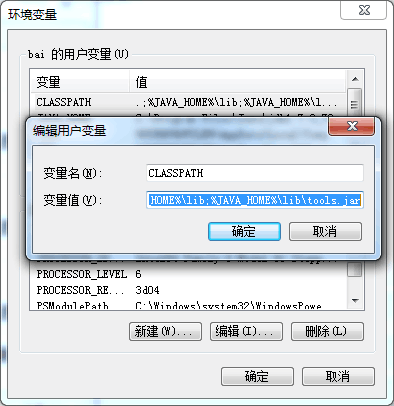 Backend Development
Backend Development
 PHP Tutorial
PHP Tutorial
 Java development environment configuration under win7 and linux
Java development environment configuration under win7 and linux
Java development environment configuration under win7 and linux
1. Win7 configuration
First download the jdk that matches the operating system version, such as the latest jdk8:
Download link: http://www.oracle.com/technetwork/java/javase/downloads/jdk8-downloads-2133151 .html;
Of course, most developers don’t know the latest Jdk. Now the mainstream choices are jdk6 and jdk7. Of course, more and more developers are switching to the jdk8 platform.
After downloading, install it all the way. The local jdk installation path is C:Program FilesJavajdk1.7.0_79
Then follow the following steps, Computer--"Properties--"Advanced System Settings--"Environment Variables
In the xxx environment Variable (xxx represents your computer name) create a new JAVA_HOME (this name is customizable, but it is generally this), and enter the value

as shown in the figure.
Second step, find Path in the system variables below, edit, and add at the end:
%JAVA_HOME%bin;%JAVA_HOME%jrebin

Then create a new variable name CLASSPATH, and enter the value. ;%JAVA_HOME%lib;%JAVA_HOME%libdt.jar;%JAVA_HOME%libtools.jar, pay attention to that point! ! !

Click OK. Windows key + r, enter cmd
and then enter the command java -version. If you can see the java related version information, it means that the java environment variable is configured successfully.
2. Configuration of Linux environment variables
Linux and win7 are both multi-user operating systems, so the location where the environment variable is configured shows the scope of the environment variable.
As above, I configured win7 under user bai, so the java environment can only be used when user bai logs in. Other users will not be able to use it. Of course, if your configuration is on the system variable, then all users on this computer can use this environment. Once you are familiar with this concept, configuring environment variables on Linux is simple.
Linux and win7 are both multi-user operating systems, so the location where the environment variable is configured shows the scope of the environment variable.
As above, I configured win7 under user bai, so the java environment can only be used when user bai logs in. Other users will not be able to use it. Of course, if your configuration is on the system variable, then all users on this computer can use this environment. Once you are familiar with this concept, configuring environment variables on Linux is simple.
Step 1: Download
Download the linux version of jdk to /usr/local, and then unzip:
$ wget http://download.oracle.com/otn-pub/java/jdk/7u79-b15/jdk-7u79-linux-x64.tar.gz $ tar -zxvf jdk-8u66-linux-x64.tar.gz $ mv jdk1.7.0_79 jdk1.7 # 重命名
Get the Jdk directory path /usr/local/jdk1.7
Step 2: Configure java for all users Environment
Log in to vim /etc/profile with root user
Press insert key, then move to the last line, add
#configuration java development enviroument export JAVA_HOME=/usr/local/jdk1.7 export PATH=$JAVA_HOME/bin:$PATH export CLASSPATH=.:$JAVA_HOME/lib/dt.jar:$JAVA_HOME/lib/tools.jar
Then press esc key, enter wq, after exiting, enter java -version if you can see it If you find the corresponding version information, it means that the Java environment variables are configured successfully.
Step 3: Configure the java environment for the current user
vim ~/.bash_profile file
Also add the following information:
#configuration java development enviroument export JAVA_HOME=/usr/local/jdk1.7 export PATH=$JAVA_HOME/bin:$PATH export CLASSPATH=.:$JAVA_HOME/lib/dt.jar:$JAVA_HOME/lib/tools.jar
Just log in again. These are two common methods.

Hot AI Tools

Undresser.AI Undress
AI-powered app for creating realistic nude photos

AI Clothes Remover
Online AI tool for removing clothes from photos.

Undress AI Tool
Undress images for free

Clothoff.io
AI clothes remover

Video Face Swap
Swap faces in any video effortlessly with our completely free AI face swap tool!

Hot Article

Hot Tools

Notepad++7.3.1
Easy-to-use and free code editor

SublimeText3 Chinese version
Chinese version, very easy to use

Zend Studio 13.0.1
Powerful PHP integrated development environment

Dreamweaver CS6
Visual web development tools

SublimeText3 Mac version
God-level code editing software (SublimeText3)

Hot Topics
 Linux Architecture: Unveiling the 5 Basic Components
Apr 20, 2025 am 12:04 AM
Linux Architecture: Unveiling the 5 Basic Components
Apr 20, 2025 am 12:04 AM
The five basic components of the Linux system are: 1. Kernel, 2. System library, 3. System utilities, 4. Graphical user interface, 5. Applications. The kernel manages hardware resources, the system library provides precompiled functions, system utilities are used for system management, the GUI provides visual interaction, and applications use these components to implement functions.
 PHP's Impact: Web Development and Beyond
Apr 18, 2025 am 12:10 AM
PHP's Impact: Web Development and Beyond
Apr 18, 2025 am 12:10 AM
PHPhassignificantlyimpactedwebdevelopmentandextendsbeyondit.1)ItpowersmajorplatformslikeWordPressandexcelsindatabaseinteractions.2)PHP'sadaptabilityallowsittoscaleforlargeapplicationsusingframeworkslikeLaravel.3)Beyondweb,PHPisusedincommand-linescrip
 PHP vs. Python: Use Cases and Applications
Apr 17, 2025 am 12:23 AM
PHP vs. Python: Use Cases and Applications
Apr 17, 2025 am 12:23 AM
PHP is suitable for web development and content management systems, and Python is suitable for data science, machine learning and automation scripts. 1.PHP performs well in building fast and scalable websites and applications and is commonly used in CMS such as WordPress. 2. Python has performed outstandingly in the fields of data science and machine learning, with rich libraries such as NumPy and TensorFlow.
 How to check the warehouse address of git
Apr 17, 2025 pm 01:54 PM
How to check the warehouse address of git
Apr 17, 2025 pm 01:54 PM
To view the Git repository address, perform the following steps: 1. Open the command line and navigate to the repository directory; 2. Run the "git remote -v" command; 3. View the repository name in the output and its corresponding address.
 How to run java code in notepad
Apr 16, 2025 pm 07:39 PM
How to run java code in notepad
Apr 16, 2025 pm 07:39 PM
Although Notepad cannot run Java code directly, it can be achieved by using other tools: using the command line compiler (javac) to generate a bytecode file (filename.class). Use the Java interpreter (java) to interpret bytecode, execute the code, and output the result.
 laravel installation code
Apr 18, 2025 pm 12:30 PM
laravel installation code
Apr 18, 2025 pm 12:30 PM
To install Laravel, follow these steps in sequence: Install Composer (for macOS/Linux and Windows) Install Laravel Installer Create a new project Start Service Access Application (URL: http://127.0.0.1:8000) Set up the database connection (if required)
 git software installation
Apr 17, 2025 am 11:57 AM
git software installation
Apr 17, 2025 am 11:57 AM
Installing Git software includes the following steps: Download the installation package and run the installation package to verify the installation configuration Git installation Git Bash (Windows only)
 How to set important Git configuration global properties
Apr 17, 2025 pm 12:21 PM
How to set important Git configuration global properties
Apr 17, 2025 pm 12:21 PM
There are many ways to customize a development environment, but the global Git configuration file is one that is most likely to be used for custom settings such as usernames, emails, preferred text editors, and remote branches. Here are the key things you need to know about global Git configuration files.





